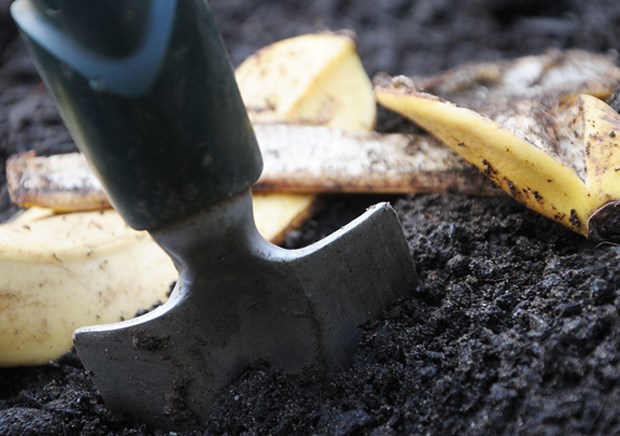Have you heard of any good garden hacks lately?
A hack, also known as a trick, is the current pop culture term for getting things done quickly. If you search the term on the Internet you'll see there's a hack for everything these days with hundreds of websites offering their own hacks or gardening tips.
Before I suggest some good garden hacks, here are some bad ones.
Bad Garden Hack No. 1: Use dental floss as a plant strap.
Any thin, wire-like material will cut into a plant's growing stem. Perhaps the dental floss stretches or something. If you're an upcycler, then try using an old garden hose, cut to any shape or thickness. Or use ArborTie straps for trees or some similar product available at landscape supply yards.
Bad Garden Hack No. 2: Put banana peels in the garden to feed roses.
This is a well-intentioned idea but if everyone in a given neighbourhood participated, rat problems would increase. I suppose if the banana peel is buried it may be less likely to smell or attract rats. The peel and throw method is similar to the idea of using egg shells to feed calcium while keeping slugs away. Both concepts are problematic in any neighbourhood.
I recommend a rodentresistant compost bin for all kitchen waste. Bins are easy to use and available from the North Shore Recycling Program (northshorerecycling. ca). Once composted, banana peels will still add nutrients to the soil, but in a prepared form.
Bad Garden Hack No. 3: Lighten a heavy container by placing packing Styrofoam chips in the bottom.
I've talked about perched water tables before. Placing any shards, pieces or chunks of Styrofoam, or any other material in the bottom of a pot reduces the depth of the root zone and perches the water table above the filler material. I suggest getting a smaller container. Or fill with soil to the bottom and grow bigger plants proportionate to the size of the container.
Bad Garden Hack No. 4: Use Epsom salts, fireplace ashes or coffee grounds as fertilizer.
Please do not. Any of those additives can negatively change soil pH and damage plant health. Epsom salts are used to adjust a magnesium deficiency over the short term. Too much Epsom will cause nutrient antagonisms, meaning magnesium and another nutrient will bind together and become unavailable to plants.
If your plants are showing magnesium deficiency, add a prescribed amount of dolomite lime to correct the problem.
Fireplace ashes are usually alkaline, poisonous and should only be disposed of in the garbage and never used in the garden.
Coffee grounds and tea bags do provide small amounts of phosphorus and organic matter. However, those items can adjust pH and saprophytic fungi may grow on the grounds leading to a less than desirable presentation.
Good Garden Hack No. 1: Grow your own moss graffiti.
This idea was sent to me by a friend living in Squamish. Moss will grow on almost any surface. The idea is to grow the moss on something like a wall, brick facade or boulder then carve, cut and scrape the moss into words, symbols or pictures. My friend carved his home address into the moss on a giant boulder near his house. This looks very cool and the possibilities are endless.
Good Garden Hack No. 2: Be water wise and use a rain barrel.
Purpose-built rain barrels can be bought online. For a DIY rain barrel, use an old garbage can or any other large, used container to hold water. You can also buy used plastic barrels on the Internet. Install a garden tap into the side of the container near the bottom. Then use leftover paint to create artistic designs or colourful schemes.
Good Garden Hack No. 3: Try homemade pest control sprays.
Let's face it, pesticides are poisonous to our children and so 1960s. Modern gardeners care about the environment's health. Buy a small, one-litre, handheld sprayer. Combine various homemade ingredients, such as cayenne pepper, garlic, onion juice or vinegar, with water and fill the sprayer and keep it stored in the fridge between uses.
Every time you go out into the garden and find evidence of aphids, whiteflies, thrips or other insect pests, simply spray some of the mixture on to the affected plants. If you do this regularly, it will help control pests in an environmentally sensitive manner.
Good Garden Hack No. 4: Consider an alternative to gardening gloves.
This trick comes from Jessica of 104homestead.com in Maine, and it's for people who don't like to wear gardening gloves.
To keep your fingernails from getting dirt underneath them, before you go out gardening, scratch a bar of soap with each fingernail. Soap will lodge under your fingernails.
Once you've finished gardening, come in and wash your hands and the soap will leave your fingernails shiny and clean.
Todd Major is a journeyman horticulturist, garden designer and builder, teacher and organic advocate. [email protected]



